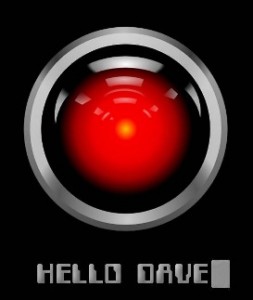 I’d rather be stuck in an elevator with Freddy Kruger than with HAL.
I’d rather be stuck in an elevator with Freddy Kruger than with HAL.
Cool as a cucumber, mind-bogglingly capable, and unfailingly and often maddeningly reasonable, HAL appears to be the perfect spaceship computer. Among other things, HAL can speak, recognize and process others’ speech, recognize faces, and interpret and mimic emotional responses. What’s perhaps more impressive and more frightening is the panic and shame he feels when he realizes he’s made a mistake.
Almost anyone can relate to the cause of HAL’s meltdown–it starts when he’s wrong about something important. HAL reports a nonexistent problem with the ship’s communications antenna, and when it becomes clear that the antenna is functioning properly, HAL goes haywire. Making a mistake compromises his ability to carry out his programmed directives and violates everything he’s supposed to be. In order to protect himself from the worst kind of failure—disconnection—HAL kills almost all of the astronauts onboard.
Perhaps we should be worried about whether our PCs have, or will have, the potential to freak out on us.
One salient difference between humans and machines is that machines don’t know when they’ve malfunctioned. They might shutdown or employ an automatic safety mechanism, but they don’t cognitively process their own malfunction or ask themselves what it means. Yet.
IBM has recently developed a “cognitive computing” microchip that simulates the innerworkings of the human brain. The chip is designed to help computers learn, rather than simply store and retrieve information.
The chip forms a “neurosynaptic core” with “neurons” that help with processing and remembering, just as they do in the human brain. The chip’s RAM works like synapses between neurons, which promote learning and recollection.
IBM’s chip would allow the computer to receive and synthesize sensory inputs, such as smell, feeling, and appearance. The chip would also promote identification and recognition–theoretically, computers could recognize obstacles and problems, as well as faces and other objects.
In other words, a computer powered by IBM’s chip could identify a failing piece of machinery on a space shuttle. It could also, theoretically, invent a problem if it could conceive of a reason to do so.
Currently, when a virus attacks, programs crash, or plug-ins stop working, computers identify a problem. But maybe those problems are like influenza or chicken pox–once potentially deadly, but now generally treatable. What remains to be seen is whether a computer with one of these chips would or could identify the problem as something more profound. Perhaps having a “brain” could cause a computer to perceive such a problem as failure, in which case you’d better hope you’re not halfway to Jupiter.
